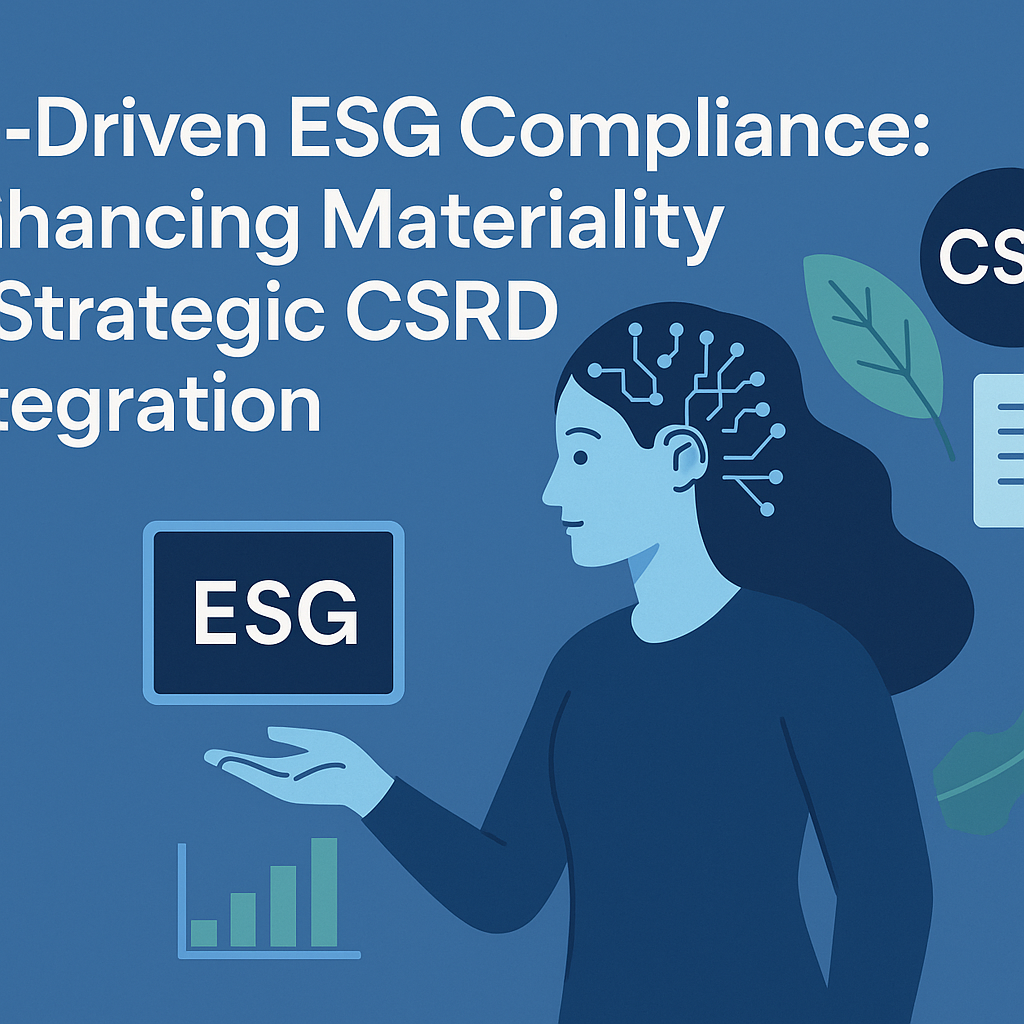AI-Driven ESG Compliance: Enhancing Materiality & Strategic CSRD Integration

Introduction
Environmental, Social, and Governance (ESG) reporting is no longer a checkbox exercise. With the Corporate Sustainability Reporting Directive (CSRD) coming into force, organizations must demonstrate not just compliance but true materiality—linking sustainability outcomes to business strategy. Yet many businesses struggle to keep pace with evolving regulations and stakeholder expectations. You need a proactive, technology-driven approach that elevates ESG compliance from a static report to a strategic asset.
The Shift from Checkboxes to Materiality
Regulatory bodies and investors alike are demanding deeper insights into ESG performance. The Dutch Authority for the Financial Markets (AFM) recently applauded early CSRD reports but urged companies to sharpen their focus on materiality and strategic integration, warning against superficial disclosures (GRC Report, Jul 3, 2025).
Similarly, the European Securities and Markets Authority (ESMA) identified gaps in how firms integrate ESG risks, calling for evidence-based controls rather than perfunctory reporting (GRC Report, Jul 3, 2025). To meet these heightened expectations, you must pivot from a compliance-only mindset to one that embeds ESG considerations into core decision making.
Challenges in ESG Reporting
- Complex Frameworks: CSRD, SFDR, and local sustainability regulations each have unique disclosure requirements.
- Data Silos: ESG metrics often reside in disparate systems—supply chain, HR, finance—making holistic analysis difficult.
- Materiality Assessments: Determining which sustainability topics matter most requires robust risk analysis and stakeholder engagement.
- Audit Readiness: Organizations must maintain transparent records to support ESG claims during external reviews and investor due diligence.
How AI-Driven GRC Platforms Empower Materiality-Focused Compliance
AI compliance automation transforms ESG reporting by centralizing data, automating analysis, and enabling continuous monitoring. Here’s how:
1. Continuous Regulatory Horizon-Scanning
AI engines ingest updates from the European Commission, national regulators, and industry bodies 24/7. When new CSRD guidelines or national ESG mandates are published, the system flags relevant changes and maps them to your control library instantly.
2. Automated Materiality Mapping
By combining regulatory intelligence with internal data, AI algorithms score ESG topics based on industry benchmarks, stakeholder priorities, and financial impact. This dynamic materiality matrix helps you prioritize disclosures that resonate with regulators and investors.
3. Integrated Data Consolidation
AI-driven connectors pull ESG metrics—carbon emissions, workforce diversity, supply chain sustainability—from multiple systems into a unified dashboard. Automated data validation routines ensure accuracy and reduce manual reconciliation effort by up to 70%.
4. Expert-Verified Insights
While AI surfaces trends and gaps, human expertise remains vital. Every AI-generated recommendation—whether adjusting greenhouse gas targets or enhancing social governance controls—flows through a human-in-the-loop review to ensure contextual relevance and strategic alignment.
5. Audit-Ready Evidence Repository
All data points, mapping decisions, and expert approvals are timestamped and stored in a secure repository. When auditors or investors request proof of materiality assessments or sustainability claims, you can deliver comprehensive evidence in minutes.
Key Benefits of AI-Driven ESG Compliance
- Strategic Alignment: Embed ESG considerations into business decisions by focusing on material topics.
- Operational Efficiency: Eliminate manual data gathering and mapping, freeing your team for high-value analysis.
- Enhanced Transparency: Demonstrate robust, evidence-based ESG reporting that meets or exceeds regulatory expectations.
- Proactive Risk Management: Identify emerging ESG risks—such as supply chain disruptions or climate impacts—before they escalate.
Best Practices for Implementing AI-Enabled ESG Reporting
- Define Scope Early: Map out which CSRD topics and national ESG rules apply to your industry and size.
- Engage Stakeholders: Involve investors, customers, and internal leaders in materiality discussions to validate AI-driven priorities.
- Set Review Gates: Establish expert checkpoints at key stages—data ingestion, materiality scoring, disclosure drafting—to maintain governance integrity.
- Train Your Team: Provide hands-on training on AI dashboards, materiality analytics, and evidence repository navigation.
- Iterate and Improve: Use post-report feedback to refine AI models and materiality algorithms for continuous enhancement.
Conclusion
Meeting CSRD obligations and integrating ESG into strategic planning demands more than manual spreadsheets and ad-hoc processes. By harnessing AI compliance automation, you can shift from superficial disclosures to materiality-driven reporting that satisfies regulators and engages stakeholders. Transform your ESG program into a strategic differentiator with technology that centralizes data, automates analysis, and preserves audit readiness. Compliance. Accelerated by AI. Verified by Experts.
Stay Updated with Our Newsletter
Join our newsletter to receive the latest updates and insights from our blog. Stay informed about compliance trends and best practices.
